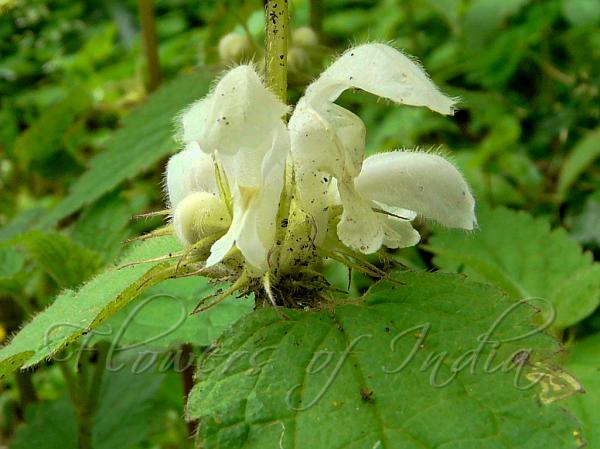|
| White Dead Nettle |
|

|

| File size | 467900 |
| Original date | 6/29/08 11:16 AM |
| Resolution | 2560 x 1920 |
| Flash | Flash did not fire, auto |
| Focal length | 4.6mm |
| Exposure time | 1/160s |
| Aperture | 4.0 |
| Focus Distance | |
| Metering Mode | Multi-segment |
| Camera make | Panasonic |
| Camera model | DMC-FZ18 |
| Sensor type | OneChipColorArea |
|
|
|
|
Photo: |
Botanical name: Lamium album Family: Lamiaceae (Mint family)
White Deadnettle is a perennial herb found in damp places in Western
Himalayas, at altitudes of 1500-3700 m. It grows up to 50-100 cm tall,
with green, four-angled stems. Ovate-heart-shaped leaves are 2.5-8 cm long
and 2-5 cm broad, with coarsely toothed margin. The leaves appear
superficially similar to those of the Stinging nettle Urtica dioica but do
not sting, hence the common name "dead nettle". Lower leaves have stalks
while the upper ones are stalk-less. The flowers are white, produced in a
few whorls, vertically separated, on the upper part of the stem. The flowers whorls arise from the axils of the upper oppositely arranged leaves. The
flowers are 1.5-2.5 cm long, 2-lipped, with a curved flower-tube with a
swollen base. The upper lip is hooded over the stamens, and is quite
hairy, with white hairs forming a fringe on the hood. The lower lip
smaller, bilobed. The young leaves are edible, and can be used in salads
or cooked as a vegetable. The plant also has a number of uses in herbal
medicine. Bees are attracted to the flowers which contain nectar or
pollen, hence the plant is sometimes called the Bee Nettle.
Flowering: April-July.
Medicinal uses: White dead nettle is an astringent and
demulcent herb that is chiefly used as a uterine tonic, to arrest
intermenstrual bleeding and to reduce excessive menstrual flow. It is a
traditional treatment for abnormal vaginal discharge and is sometimes
taken to relieve painful periods
White dead nettle is an astringent and
demulcent herb that is chiefly used as a uterine tonic, to arrest
intermenstrual bleeding and to reduce excessive menstrual flow. It is a
traditional treatment for abnormal vaginal discharge and is sometimes
taken to relieve painful periods
Medicinal uses:
 White dead nettle is an astringent and
demulcent herb that is chiefly used as a uterine tonic, to arrest
intermenstrual bleeding and to reduce excessive menstrual flow. It is a
traditional treatment for abnormal vaginal discharge and is sometimes
taken to relieve painful periods
White dead nettle is an astringent and
demulcent herb that is chiefly used as a uterine tonic, to arrest
intermenstrual bleeding and to reduce excessive menstrual flow. It is a
traditional treatment for abnormal vaginal discharge and is sometimes
taken to relieve painful periods | Identification credit: Tabish | Photographed at McLeodganj-Triund route, Himachal Pradesh. |